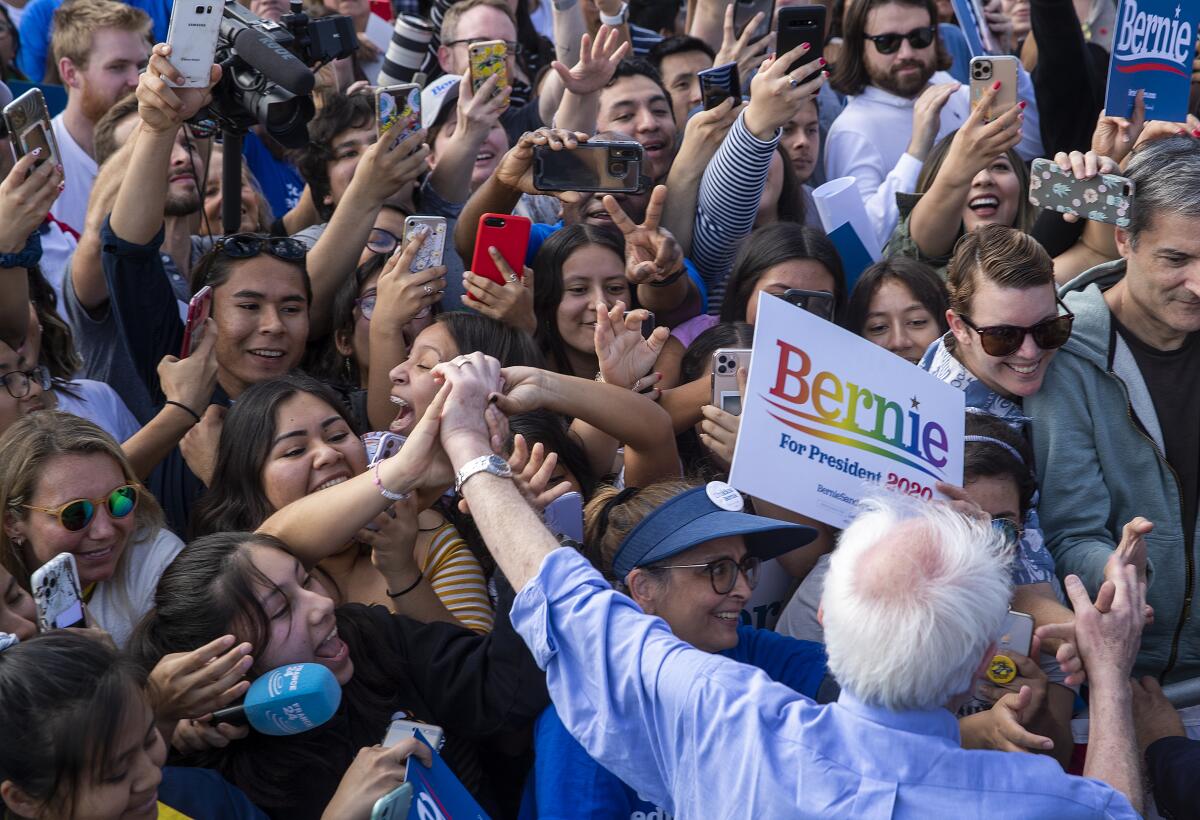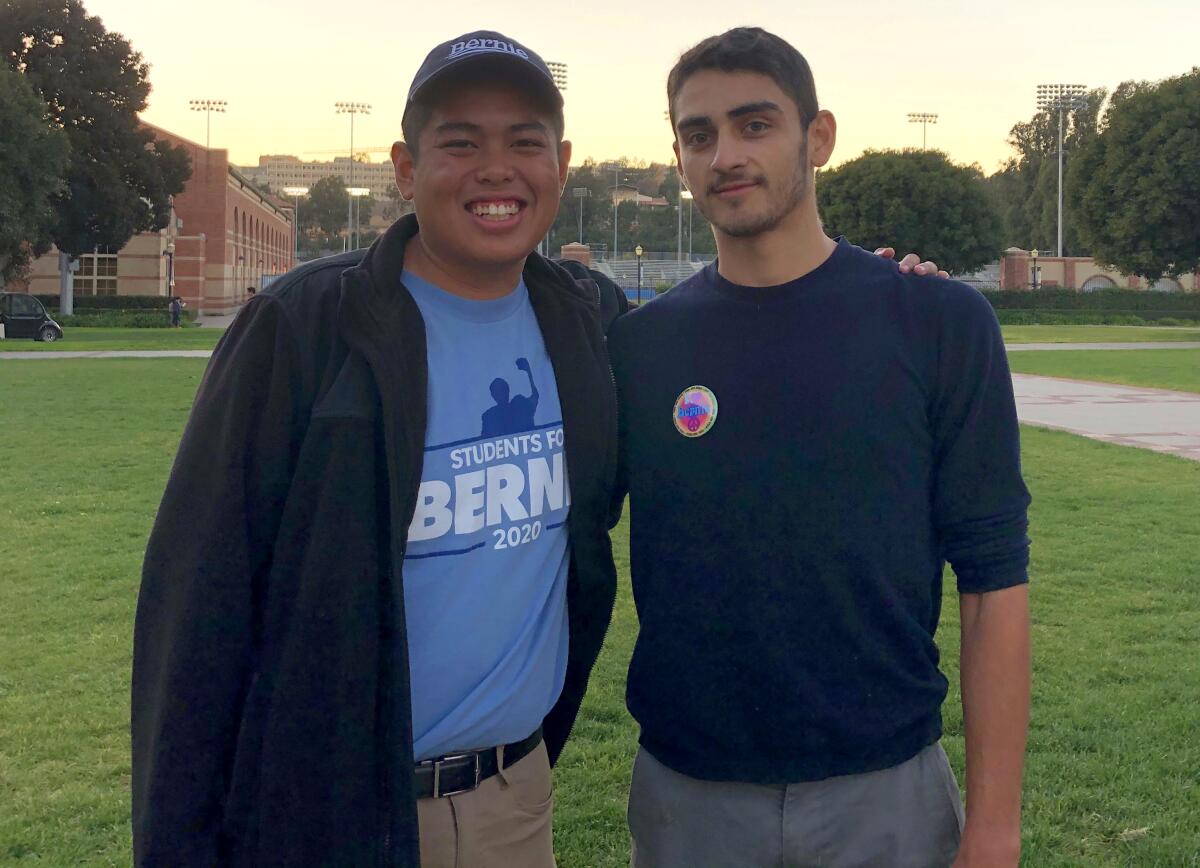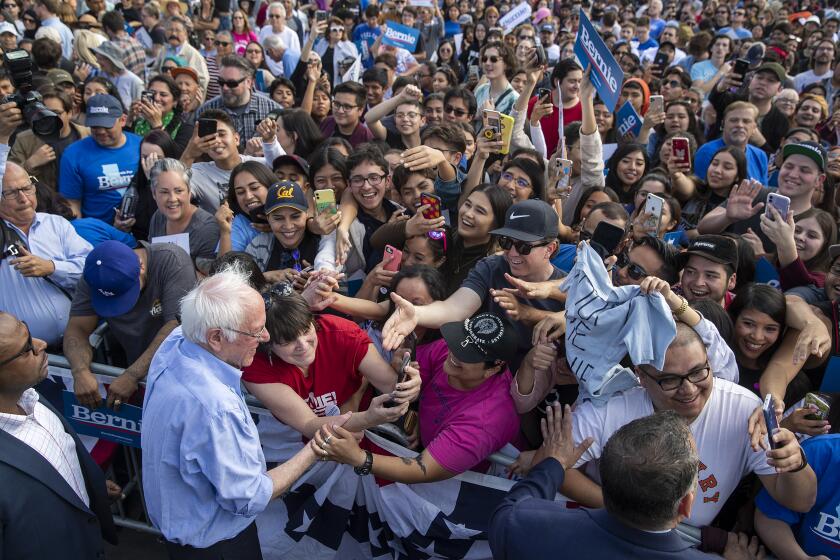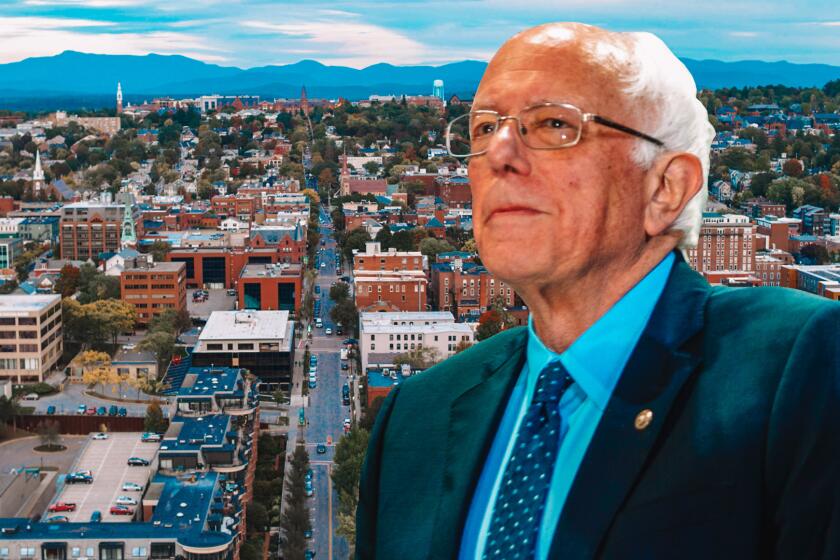Just what is it about Bernie Sanders that young voters love?

It is one of the most consistent — and counterintuitive — facts behind Bernie Sanders’ four-year march from insurgent presidential contender to front-runner: The oldest candidate in the Democratic field owes his success to the youngest voters in the party.
Sanders, 78, with a surly resting face and a disheveled halo of thinning white hair, may seem like an unorthodox choice for voters several generations removed. But with his defiance for convention and decades-long crusade for revolution, Sanders is uncommonly in sync with the political sensibilities of younger Americans hungry for sweeping action on climate change, student debt and healthcare.
For younger voters, their formative years have primed them to embrace more radical politics. The warnings they hear from scientists about the consequence of climate change have become increasingly dire. The frequent school shootings that have made lockdown drills a normal part of life have prompted students to call for more government regulation on guns. The Great Recession — which hammered millennials as they entered the job market while Generation Z watched their parents weather the downturn — instilled a deep skepticism about Wall Street and, more broadly, the country’s economic structures.
Sanders may come across as angry. But young voters consider the problems at hand and figure, why shouldn’t he be?
“You have people that actually criticize him for being so passionate and yelling at you,” said Norma Sandoval, a UCLA graduate student in molecular biology. “But you see that he truly does want what’s best for the majority of the people.”
Ideological affinity, coupled with a head start on youth organizing from his 2016 campaign, has made the Vermont senator a formidable favorite among millennial and Generation Z voters. Sanders won approximately half of voters under 30 in the Iowa and New Hampshire contests, according to the Center for Information and Research on Civic Learning and Engagement, or CIRCLE, a research organization at Tufts University, and two-thirds of younger voters in Nevada.
“If anyone is going to try and dig into his lead, they’re going to have to go through the youth vote,” said Ben Wessel, executive director of NextGen America, an advocacy group focused on youth turnout.
Bernie Sanders has broad support among communities of color in California, a new poll finds. Among Democratic hopefuls, Joe Biden and Michael Bloomberg trail Sanders.
Sanders, for his part, has made young people central to his path to victory, arguing that only a candidate that inspires turnout from new and infrequent voters can win the White House. But there has not been an overwhelming surge in turnout in the first three nominating contests.
“We’re not seeing some crazy overwhelming storming of the polls by Bernie-stans,” Wessel said, using the internet parlance of fandom. But, he noted, the candidates who have performed best with young voters — Sanders, followed by Pete Buttigieg — are the ones leading the delegate chase. “It’s young vs. old right now in this primary ... and right now the youngs are winning.”
Many young voters jumped into politics first rallying around an issue — be it Dreamers fighting for immigration reforms or youth-led strikes demanding action on climate change — rather than a specific politician. Philip Agnew founded an organization for criminal justice reform after the shooting death of Florida teenager Trayvon Martin. Recently, he has been on the road for the Sanders campaign, holding events at college campuses in at least eight states.
“It is the platform; it is the policies. Those outlast any person, and those are generational ideas,” said Agnew, 34. “To hear them repeated back to them by somebody wanting to be president of the United States is a huge boost of affirmation for [young people].”
For many Democrats desperate to beat President Trump, their paramount concern has been who has the best general election prospects — a calculus that has been difficult to pin down in a volatile political landscape.
Young voters, however, are less preoccupied with electability. A poll commissioned last year by the Alliance for Youth Action found that by a 2 to 1 margin, respondents under age 34 said the 2020 presidential election should be about “bold policy change” instead of focusing narrowly on kicking Trump out of office.
“No kidding, we want to defeat Donald Trump,” said Sarah Audelo, executive director of the group. “But that is a really low bar for the type of country we’re trying to create.”
Sanders’ platform of “Medicare for all” and sharply reducing costs for higher education resonates with Justin Alvarez, 20, a diabetic who worries about juggling the expenses of insulin, rent and tuition.
“Bernie is the only one I can really rely on and trust to take on the pharmaceutical companies that jack these prices way up,” said Alvarez, who leads a Students for Bernie group at Santa Monica College.
Burlington shaped Sanders as Sanders shaped Burlington, so much so that it’s hard to consider one without the other.
Younger voters tend to be more progressive than their older counterparts, and are more likely to hold positive views of socialism, a boon for Sanders, who proudly labels himself a democratic socialist. But John Della Volpe, director of polling at the Harvard Kennedy School Institute of Politics, cautioned against reducing youth support for Sanders to just a desire for free stuff.
“Sanders is supported by millions of young people despite the socialist label,” Della Volpe said. “He’s painting a picture of an America that is inclusive. It’s fair, it’s respectful, it’s where neighbors help neighbors.”
Sanders has long kept the Democratic establishment at arm’s length, which causes some party stalwarts to grumble about loyalty. For younger voters, who are less likely to be affiliated with a political party, that critique falls flat.
“I think that by virtue of being an outsider ... he is able to actually stand up for [the working class],” said Alejandro Rico-Gomez, 18, a freshman at USC who traveled nearly three hours by bus and Lyft to Palm Springs to vote for Sanders at a satellite Iowa caucus this month.

With his arms akimbo and fingers jabbing the air, Sanders can seem almost cartoonish in his expressiveness. Some fans have captured the essence in a meme derived from the television show “The Simpsons,” transposing his face onto a newspaper with the headline “Old Man Yells at Cloud.”
His hollering — which Sandoval maintains is not yelling but fierce excitement, the kind where a little bit of spit flies out and maybe a bit of frustration, too — reminds Sandoval, the UCLA student, of her grandfather — who, she said, does not shy from hard truths. She appreciates Sanders’ candor.
There are “so many things that need to change, that some people, for some reason, don’t understand. So it is infuriating,” said Sandoval, 28. “But I think he keeps his cool as best as he can.”
The frustration Sanders and his supporters share is so galvanizing that some have jumped from activism into running for office themselves. Elizabeth Alcantar, 26, didn’t think her representatives on the Cudahy City Council were sufficiently responsive, so she ran in 2018, inspired in part by Sanders’ first presidential bid. She won and now serves as mayor.
“Bernie not only gives us his vision for the country,” she said, “but it’s something that we share.”
Sanders’ polling numbers with the younger demographic bounced around during the spring and summer of last year, as voters considered other candidates in the crowded Democratic field.
“They didn’t just stick with him in the beginning,” said Ben Tulchin, Sanders’ campaign pollster. “They shopped around. We had to earn their support back.”
The primary competition for younger voters was another progressive in the race, Massachusetts Sen. Elizabeth Warren. But her polling began to slide when scrutiny of her healthcare plan ramped up, and Sanders was able to consolidate young voter support in the fall, boosted by a high-profile endorsement from Rep. Alexandria Ocasio-Cortez (D-N.Y.), a millennial.

The Sanders team projects confidence that the youth vote has come home for good. Now, they’ve got to make sure they come to the polls.
“The first challenge is to persuade people they should support you. The other challenge is making sure they show up at the right time to vote,” said Jeff Weaver, a Sanders senior campaign strategist. “Younger people don’t have as long a voting history.”
The biggest test case for Sanders’ ability to turn out young voters will come next week on Super Tuesday, which will dramatically expand the number of people going to the polls. California, with the largest slate of delegates up for grabs on Tuesday, is especially rich with opportunity for Sanders; while young adults make up a third of the state’s population, they are only 20% of California’s likely voters. If Sanders makes inroads to close that gap, that could mean millions of additional votes.
“These are remarkable numbers that could really shape the election in ways we haven’t seen in the past,” said Mark Baldassare, president of the Public Policy Institute of California, “but the question is who’s going to be motivated enough to vote.”
More to Read
Get the L.A. Times Politics newsletter
Deeply reported insights into legislation, politics and policy from Sacramento, Washington and beyond. In your inbox three times per week.
You may occasionally receive promotional content from the Los Angeles Times.














